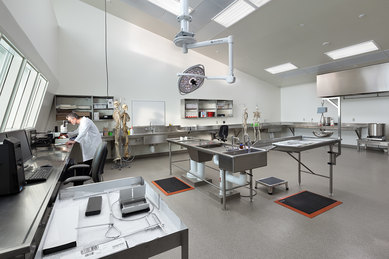Forensic Medicine
Medicolegal Autopsy Facility
Laboratory space design represents a highly specialized challenge for facility owners, architects, and engineers. It requires unique skills and customized approaches tailored to creating optimal, well-calibrated environments for use by medical personnel, scientists, and technicians. Yet more specific challenges arise based on their functional needs and objectives-and medicolegal autopsy facilities represent an especially challenging set of criteria for project design teams.
Buildings and interiors for medicolegal autopsies have unique demands and functional criteria not seen elsewhere, due to their unique mission: to facilitate forensic services, support medicolegal autopsy policies and procedures, and successfully accommodate varying investigation methods into the causes and manners of death which are of public interest.
Moreover, medicolegal autopsy facilities require core spaces designed for critical analysis and work flow such as body storage, autopsy rooms, imaging, forensic anthropology and associated labs. The facilities must also support the work flow of specimen processing with adherence to strict legal requirements for evidence handling and chain of custody. Accommodations for the handling of mass fatality events are an important aspect to evaluate. Life-safety considerations include support protocols for such biohazards as infectious aerosols and other exposures of forensic medicine.
Last, because of the sensitive nature of the subject matter of medicolegal autopsy facilities-due to associations, odors, and stark views of the deceased-facility designs must pay attention to developing appropriate means to accommodate visitation and tours, as required, by non-staff professionals and civilians, including families of the deceased.
